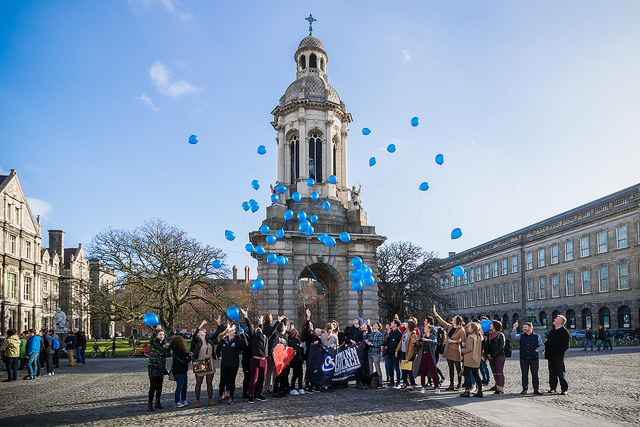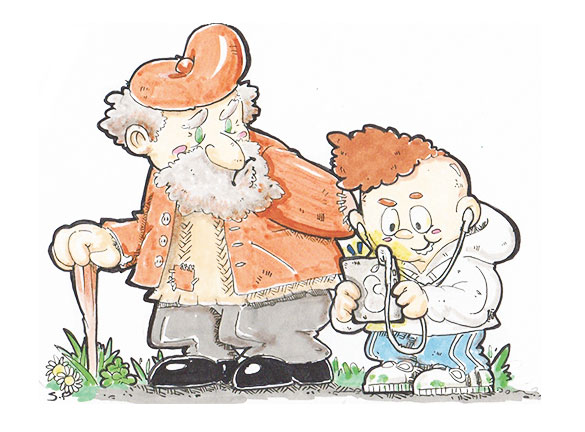Walking briskly down Nassau Street to the train station on one of the first few days of term, I noticed two people following leisurely behind me, chatting about the weather. Their conversation was so relaxed, so casual, that I hardly noticed they were speaking Irish. It didn’t seem out of place. There was no glaring aberration on the linguistic landscape. Though it might not always be so clear as this, there is a feeling that, even just outside Trinity College, in what can only be described as the very centre of the Pale, the Irish language is being used more and more in everyday life.
Is Irish undergoing something of a revival these days? Have we reached a turning point in the beleaguered history of a language that, for so many people, conjures up images of classrooms, school work and little more? Maria Schäler, Vice-President for the Irish Language at the Union of Students of Ireland (USI) shows little doubt on the matter. In an email statement to The University Times, she explained, “I think there is a revival going on at the moment. It certainly can’t be denied that Irish is very much alive.” She is of the opinion that “we have seen massive growth in the amount of speakers and interest in the language as of late.”
And it appears that students have an important role in this revival. Schäler emphasises that there is a “young and renewed energy that’s emerging” which is a pivotal cost of this development. “Young people aren’t so cynical towards the language as previous generations,” she explained to The University Times. “There’s a view at the moment among young people that the language is very much alive and that it’s worth using.”
There’s a very old-fashioned image of Irish that’s very prevalent, but despite that young people are still showing an interest
This outlook is exemplified by Áine Haberlin, Reachtaire of Trinity’s Cumann Gaelach. Speaking about the state of the language among young people to The University Times, she confirms that there is interest in Irish despite the challenges that it faces. “There’s a very old-fashioned image of Irish that’s very prevalent, but despite that young people are still showing an interest.”
It is clear from her approach to her role in the Cumann Gaelach that she is eager to change this perception of Irish. “More informal events are really important to give confidence to people who don’t yet feel comfortable in the language but who have an interest in it,” she explains. It is perhaps for this reason that she is so full of praise for Ravelóid (a play on the Irish word for “revolution” and an English term for a musical event wholly distinct from a ceilí), an Irish language music festival that was organised to take place last summer, but that was cancelled following low ticket sales.
This revival of the language appears somewhat broader than the relatively narrow ambit of student life. Eoin Mac Cárthaigh, Assistant Professor at Trinity’s School of Irish has an optimistic view on the development of the language. “There’s a lot more literature written in Irish than you’d expect given the number of speakers it has – it is after all, a minority language” he explains to The University Times. “Liam Mac Cóil, for example, is a talented novelist, and, if he was writing in English, there would be significant demand for his work.” Mac Cárthaigh acknowledges other, more democratising trends in Irish literature, explaining that “popular literature and children’s literature in particular is becoming much more common in the language.”
The Irish language and its use is spreading and becoming more and more a part of people’s everyday lives. Julian de Spáinn, High Secretary of Conradh na Gaeilge, affirms that the Irish language enjoys the favour of the public. “The Irish people are loyal to the Irish language and want to use it,” he told The University Times, emphasising that more than a million people in the country speak the language. Schäler also attests to the currency of the language. “It’s clear that the language is being used more and more across the country because of the significant efforts of Gaeilgeoirí on its behalf.” However, de Spáinn is keen to emphasis that any such revival is not a new development.

“The revival of the Irish language began in 1893 with the founding of Conradh na Gaeilge,” he told The University Times, expressing a markedly long term view. It is perhaps easy for our generation to, somewhat narcissistically, think that we are on the cusp of a new era in the language’s development. It is altogether too easy to construct this narrative of uniform and continuous decline in Irish before some recent and sudden revival. It is, therefore, important to acknowledge that this new found energy that surrounds the use of Irish is really only the latest step in a long history, and the continuation of a sometimes uncertain process of recovery from the damage done to the language by the Famine in the mid-nineteenth century. We should not forget other moments of resurgence in the language’s history. After Irish independence in 1922, the Irish language was made a core subject in the education system and benefitted from state support and funding.
However, the language’s relationship with the state has not been a stream of continuous support. If there is any revival, be it recent or on a much longer scale, it has, in places, continued despite, rather than because of, government action. Haberlin argues that the government’s education policy is damaging the language. “The Leaving Cert is terrible for the Irish language,” she told The University Times, explaining further that “so many people develop a negative attitude towards the language over the course of their time in school and preparation for the Leaving Cert”. But has education policy not helped Irish at all, particularly through making it a long standing compulsory subject for virtually all students?
Jeffrey Kallen, Assistant Professor in Linguistics and Phonetics in Trinity believes it has. “I think the means which have been taken to use the education system to ensure the continuity of Irish for the population as a whole and to strengthen the Irish-language community where Irish is used as the main language have shown a considerable amount of success,” he suggested to The University Times, acknowledging nevertheless that “a great deal of the richness of the language has not been transmitted in the schools.” De Spáinn also recognises these positive aspects of the role Irish currently plays in the education system, but nevertheless calls for reform. “It’s great that Irish is still a core subject but there is so much more to be done,” he explains. “The government must put in place a standard Irish course that would be compulsory for every student,” he recommends, “and there should be a more advanced Irish course for students studying in Gaeltachtaí and Gaelcholáistí that would be based more on literature and translation.”
Events like debates and plays are very difficult to organise when people lack confidence in their Irish… the most important people for the language are those who are not actively using it, but who have an interest in it
Perhaps a more refined and ambitious system is necessary in order to strike a balance between the need to give basic skills and confidence to those people who are learning Irish as a second language and enhance the expression and understanding of fluent Gaeilgeoirí. There are two different types of student studying Irish participating in the education system and it may be that recognising their diverging needs may increase the overall standard of Irish.
If improving the overall competence of people in the language is our aim, and if we want this revival of Irish to continue, what else can we do? It is obvious from Haberlin that the challenge is a complicated one as she speaks of the difficulties of nurturing interest in Irish within the walls of Trinity. “Events like debates and plays are very difficult to organise when people lack confidence in their Irish,” she explains, emphasising that “the most important people for the language are those who are not actively using it, but who have an interest in it.” This is undoubtedly an important message to the Irish speaking community given that, although 1.77 million people have some ability to speak the language according to the 2011 Census, only 110,000 use it outside the education system on a weekly basis.
Even less people, 77,000 in fact, speak it on a daily basis. This means that an ability to speak Irish is already widespread in society, and the challenge remains to be that raising interest in the language. It is likely that this contemporary image of Irish, without the ancient, academic complexity with which it is so often associated, has a vital role in this change. De Spáinn agrees that “there needs to be more emphasis on young people and on clubs and societies,” adding that “there should be an Irish language centre in every town in the country to give people the opportunity to speak the language informally.” Both in universities and outside of them, it is obvious that people simply will not speak Irish if they do not have spaces in which they are encouraged to speak it, and it is because of this that organisations with links to society, such as the Cumann Gaelach and Conradh na Gaeilge, are so important. They are able to organise events where people can enjoy each other’s company in exactly the same way as they otherwise would, except through the medium of Irish. It is this that I have heard most consistently from those seeking to promote the language: we have to give opportunities to people to use Irish in exactly the same way as they would speak any other language.
The budget for Gaeltachtaí and the Irish language authorities have been cut from €45 million in 2008 to €22 million in 2015
However, this certainly does not clear the state of its responsibility in this regard. Resources that support the language and that make services available through it are in decline. It is for that reason that organisations like Conradh na Gaeilge have been urgently lobbying the government, both before and after the budget. In a press release, Cóilín Ó Cearbhaill, the organisation’s president put it in particularly stark terms. “The budget for Gaeltachtaí and the Irish language authorities have been cut from €45 million in 2008 to €22 million in 2015.” We can see this perhaps most clearly in the unsuccessful attempts of those trying to exercise their right to communicate with the state through Irish.
From my own experience, making the decision to adjust your tax credits through irish on the phone is an unwise one and will be met by an interminably long wait followed by the sound of a fire alarm, at which point you will likely give up. This is not exactly providing people with a casual opportunity to speak Irish. It is not only with the energy of its activists that a language will be preserved.







